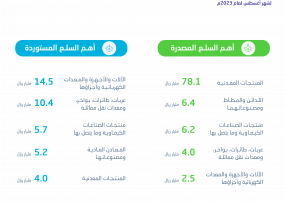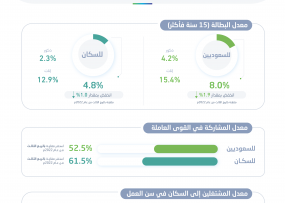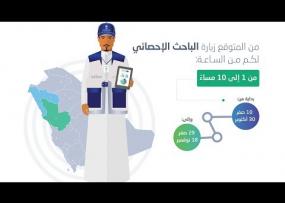Last update 12 / 09 / 2017
35 Terms Used in the Household Economy Survey

1. Administrative Region:
It is a part of KSA, the administration of which is supervised by a governmental authority directly affiliated to the Ministry of Interior (such as: Riyadh Region, Makkah Region, etc.) For each region, there is a capital city (metropolis) where the Emirate HQ is located.
2. Governorate:
Part of the administrative region, and the first administrative level within the administrative region which is affiliated to it administratively (such as al-Kharj Governorate, affiliated to Riyadh Region).
3. Municipality:
Administrative subdivision of the governorate, such as al-Dalam Municipality affiliated to al-Kharj Governorate. Some municipalities are directly affiliated to the region emirate, such as Arqa Municipality affiliated to Riyadh Region. Still, there are municipalities affiliated to other municipalities, such as Oyayna Municipality affiliated to Halat-Amar Municipality in Tabouk Region.
4. Populated locality:
Any place comprising a permanent populated settlement (such as a village or a farm), and it could be non-permanent (such as a water resource).
5. City:
Each populated locality with a municipal council, or is inhabited by more than 5,000 persons.
6. District:
Part of a city comprising buildings, streets, and roads. It has a known name and it is usually surrounded by main streets separating it from other districts. City districts are numbered, starting from 001. The cities were divided into districts as per the schemes adopted at municipalities and city HQs.
7. Neighborhood:
A statistical division used for census purposes in cities. It is a geographical area representing a part of the district and it is usually surrounded by main streets from all sides. District neighborhoods are numbered, starting from 01.
8. Counting area:
It is a statistical division consisting of definite geographical area comprising a number of buildings, housing units, and households, at an average of 150 households. It is regarded as the primary primary sampling unit (PSU).
9. Block:
It is a geographical area surrounded by streets from all sides. It consists of one or more adjacent buildings which are not separated by streets. A block may be shaped as a square, a rectangle, a circle or it may have an irregular shape such as the ancient districts. A block may also be an open area. Neighborhood blocks are are numbered, starting from 001.
10. Building:
It is any independent construction, permanently or temporarily built on land. A building might be single- or multi-story. It contains one or more rooms, with one or more doors leading to all or most of its parts. A building may be inhabited or not. It may be constructed to be inhabited, or to be used for practicing any economic, social or religious activities, such as: building, villa, traditional house, hut, government house, hospital, mosque, etc. Block buildings are are numbered throughout the populated locality.
11. Dwelling:
It is a single- or multi-room unit which is primarily prepared for one household and has one separate door, whether it was still under construction, vacant, inhabited, occupied, or used for professional or public health purposes during the survey and enumeration. The dwelling might accommodate one or more households, one or or more businesses, or a household and a business simultaneously. For the census purposes, every inhabited building during the numbering period shall be counted as a dwelling, even if it was not set up for that purpose, such as: shops, workshops, and schools, in addition to all types of houses: villas, traditional houses, apartments, tents, huts, cottages, and hair houses.
12. Time reference
There are reference periods for the Household Economy Survey 1439H (2017); they are:
a. Time reference of the population and housing data: day of the visit to the household.
b. Time reference of household inn come and expenditure: month of the last household survey before the visit.
c. Time reference of the work data: the week preceding the data of the visit.
d. Time reference of the views and suggestions: last or next year.
13. Household:
According to the actual counting method, a household is defined as an individual or a group of individuals who have or have not a kinship relationship, share the housing unit and food, and live in the housing unit at the survey time. The persons listed below are considered household members:
- Persons usually residing with the household, but are temporarily absent at the time of the survey, for being somewhere in the Kingdom or abroad. These include: businessmen, tourists, and persons on business trips or scholarships;
- Persons usually residing with the household, but are temporarily absent for work circumstances, such as: guards, doctors, nurses, airport workers, and fishermen;
- Household workers, such as servants, drivers, etc, residing with the household; and
- Household members on travel at the time of the survey.
14. Head of the Household:
At least 15-year person who is considered the chief member by other members of the household and looks after whoever living with him. Mother shall be considered the head of the household provided that it consists of a women and her children.
15. Nationality:
Name of the country to which an individual politically belongs, regardless of the place of birth. A field in the survey is dedicated to registering the individual's nationality, whether s/he is Saudi or foreigner. As for foreigners, their nationalities must be specified (e.g., Egyptian, Indian, Pakistani, South-Korean, etc). The household member's nationality must not be inferred or deduced from the household head's nationality, as the household might include distinct nationalities. As for the persons with more than one nationality (carrying more than one passport), one nationality could be selected (the one based on which s/he entered the Kingdom).
16. Marital status:
All household members must be categorized according to their marital status. Each individual must fall into one of the following categories:
• Single
• Married
• Divorced
• Widow/er
• Undivorced/ Deserted Woman:
- An 'undivorced woman' is the wife who appeals to the court to get a divorce, but has her plea denied by her husband.
- A 'deserted woman' is the wife abandoned by her husband, who no longer provides for her for over three months. The status must be substantiated by a legal document proving desertion, or a decision by her household.
17. Population:
All individuals, Saudis and non-Saudis, living in the Kingdom at the time of the survey.
18. Survey population:
Members of the households selected in the sample, including domestic workers, and the like, who live in one house.
19. Population in work age:
All individuals aged 15 years and over, whether economically active (labor force), or economically non-active (not included in the labor force).
20. Labor force (economically active population):
They are all individuals aged 15 years and over, whether employed or unemployed.
21. Workers:
They are the individuals (15 years and over) who, during the reference period (the week preceding visiting a household):
• Worked for at least one hour for a salary or a wage (in cash or in kind) as regular or temporary employees, employers or self-employed individuals;
• Assisted one of the household members for at least one hour for free in any type of business or in a farm owned by one of the members of the household;
• Worked for at least one hour for others without a wage or a profit (in cash or in kind) as volunteers; or
• Were temporarily absent from work all the week due to a leave, an illness or for any other reason and are scheduled to resume work.
Thus defined, workers include the students, job seekers, retirees, housewives, etc., who worked during the week preceding the visit for at least one hour, provided that this does not include household work, such as cooking and washing carried out by the housewife, or regular household maintenance work carried out by one of the household members.
22. The unemployed:
They are the individuals (15 years and over) who, during the reference period:
• Were workless during the week preceding the household visit;
• Seriously looked for work during the four weeks preceding the household visit (followed at least one method to find a job). Included under this category are those who did not search for work during the four weeks preceding the household visit because of waiting to get work or set up their own business during the coming period, given that they already have searched for work before the fixed time); or
• Are able to work and ready to join it when available (i.e., when the are available for work) during the week preceding the household visit.
23. Population not included in the labor force (economically non-active population):
They are the individuals (15 years and over) who are not classified within the labor force (workless or unemployed), because they do not work during the week preceding the household visit, and do not search for work during the four weeks preceding the visit. Nor are they ready to join it during the week preceding the said visit. This category includes students, housewives, non-working retirees, and individuals who are unable to work, as well as those unwilling to work or to seek jobs for any other reasons.
24. Profession:
The main work practiced by an individual, regardless of the activity of the entity they work for. In case the individual doesn't work during the week preceding the visit, but worked before, they may register their previous profession, provided that the profession is specified in detail. So, for instance, instead of writing "writer", "worker", or "employee", they may record it as follows: "medical record writer", "agricultural worker", "tailor", etc. And in case the individual has more than one profession, they may register the one they spent longer time in, or consider as their main profession. And if it happens that the individual practices a profession different from their main profession during the week preceding the visit, the main profession only sall be registered.
25. Economic activity:
What are the main services or products manufactured by the entity for which the person has been working during the last week or while she/he was doing the last job?
26. Occupational status:
The occupational status of an individual refers to their status in the economic activity, in terms of their rights, type of contract, whether the contract is signed with another individual, or with an organization, etc. The occupational status in KSA falls into one of the following categories:
• employee
• employer
• Self-employed
• Household-supporting worker
• Member in producer cooperative
27. Employment Sector:
The employment sector involves all organizations working in similar types of economic activity. The sector could be a sub-sector of a main economic sector, as is the case in the oil production sector, the service sector (involving an array of economic activities), or the cluster of economic activities provided by the informal sector. The employment sectors in KSA falls into one of the following categories:
• Government Sector
• Public Business Sector
• Private Business Sector
• Self-employment Sector
• Household Business Sector
• Charity Sector
• Domestic Work Sector
28. Household income:
For the purposes of this survey, by the household income is meant the aggregate incomes of household members (regardless of their age or gender), calculated over the year preceding the household visit, which is available to the household to be spent on the various objects of expenditure, saved, or invested.
To cover its expenses, the household usually depends on its various income resources. In case of the incapability of covering its expenses, the household resorts to covering such deficit by carrying out some sort of capital or transformational processes (selling a plot or securities, or borrowing from others, etc.)
Likewise, if there is a household surplus, as a result of the increase of its income compared to expenses, the household usually saves or invests the surplus (buying gold, a plot, or securities, or saving in the banks, etc.)
Sources of the household income are categorized as follows:
o Salaries and cash and in kind wages including overtime pay, allowances and bonuses;
o Income obtained by rents of real estate properties, including buildings and non-agricultural lands;
o Net income from projects in (commercial, industrial, agricultural and service establishments as well as free professions, and profit of stocks speculation, etc);
o Net income from projects outside the establishments, i.e. the business carried out outside the establishments and that has no fixed place for carrying out the business such as salesmen and taxis (transport, passengers, cargo, etc);
o Net income means the total revenues (production) of which operation charges (salaries, wages, service, and raw materials) are subtracted;
o Property income: including distributed profits of stocks, shares, securities, investment certificates, distributed revenues, drawing out from quasi-corporations, agricultural lands rent, intellectual property income, interest on deposits and accrued bonds of any one of the household members during the survey year, whether from inside or outside KSA;
o Income from current transfers, i.e. government aids (cash or in kind) charity establishments aids, aids from individuals and relatives (among households), pension remunerations,social insurance, insurance companies compensations, and other current transfers such as bridal money, alimony, inheritance, and awards of competitions, etc; and
o Income from household production (outside the establishments), securities, loans (whether from institutions or individuals), as well as used durable goods sales, assets sales, loan repay, drawing from previous savings, grants and gifts, etc.
29. Household Expenditure:
The household expenditure is defined as the aggregate expenditure spent on consumer commodities and services, as well as non-consumer commodities and services of the household. By non-consumer commodities and services are meant the expenses incurred by the household with relation to obligatory and semi-obligatory government payments, as well as payments to other non-profit institutions or other households, or spending on commodities or services without possession of any such commodities and services in return for meeting the needs of their members. The household expenditure, thus defined, is the aggregate expenses incurred by the household to meet its needs, and fulfill its obligations.
In other words, it is the aggregate payments spent by all household members in return for the commodities and services they get. This includes payments related to the household as a whole (such as spending on food, housing or electricity), or related to some household members (such as spending on clothing, personal tools and so on) during the reference period of the survey.
The household expenditure covers, besides, the expenses of the servants and their equivalents, as well as consumption of any commodity produced by the household, or anything obtained from an economic establishment owned by the household during the survey reference period.
30. Dwelling holding:
The holding refers to the household's arrangements to get a dwelling to live in. The holding might take one of the following forms: a dwelling leased, possessed, obtained from the employer, obtained for free, etc. The holding might be a dwelling, or a part of it. The types of holding are: possessed or hired by members of the household (in full or in part), obtained from the the employer, obtained for free, etc.
31. Dwelling mortgage:
A loan that enables the borrower (whether an individual or organization) to borrow money to buy a house or any other real estate. The borrower's ownership of this real estate functions as a guarantee of the loan. This means that if the borrower fails to repay the loan, the lender shall have the right to take the actions to own the real estate. Otherwise, the real estate shall remain mortgaged till the loan is repaid. That is why the lender is referred to as the 'mortgagee', whereas the borrower is referred to the 'mortgagor'.
A number of Islamic scholars have agreed that this loan, contrary to other types of loans, is religiously permissible. Others have insisted that it is prohibited. For them, it is subject to the same religious contraindications as those that apply to the rest of loans.
32. Saving:
Saving is a basic economic phenomena that applies to the individual and community levels. It is the amount not spent from the income, or the difference between the income and the amount spent on consumer commodities and services. Accordingly, savings are sometimes referred to as "surplus".
Saving is achieved by subtracting a certain amount of the income with aim of forming a reserve. This reserve could be used for investment, or to be utilized later. On the individual level, saving helps reduce risks, and protect money from potential dangers. Saving is of two types:
Optional saving: free saving that an individual opts to conduct voluntarily, in response to their will and desire, and as a way to make balance between two contradicting wills: the will to spend, and the will to refrain from spending.
Obligatory saving: a type of saving forced on individuals by a legal requirement, government resolution, or corporate decision. Pension is regarded as obligatory saving.
33. Assets:
By assets, in the business and accounting contexts, are meant the economic resources owned by individuals, businessmen or companies. It is defined as any tangible or intangible property, acceptable for repaying debts. It could alternatively defined as personal properties with a value that could be easily transformed into money (given that money itself is considered as an asset.)
34. Financial status of the household:
The economic status and financial organization of a household are fundamental concepts when it comes to approaching household statistics. The economic status and financial organization refers to the way through which the household meets its human needs. The need is defined by the desire to get something, whether that thing is tangible (commodity), or intangible (service). The readiness of the household to pay the cost of such a needs is positively correlated with its ability to pay, and the importance of that thing from its point of view.
Household needs usually fall under one of the following types of needs: food, clothing, housing, security, social needs, cultural needs, transportation and communications.
35. Living costs:
The cost necessary to maintain a certain living standard. Such costs include the daily costs needed by the household to spend on food, clothing, transportation, and the like.










